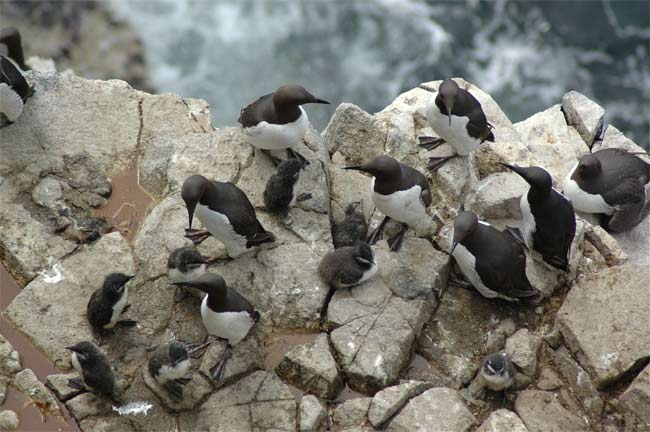Food Shortages Drive Birds to Murder Chicks

Adult seabirds in Scotland have launched brutal attacks on chicks from nearby nests, sometimes pecking to death the fledglings or just flinging them from cliff ledges. The ferocious attacks were documented in a study announced today.
"The attacks were brutal and usually involved more than one adult as chicks fled from the initial attacking neighbor," said lead researcher Kate Ashbrook of the University of Leeds in England.
The newly discovered bird killings are par for the course in the avian world where birds are known to be pretty wild. Among Nazca boobies on Galápagos Island, murder is rampant. On a popular web cam, an eagle chick killed its sibling in 2006. Long ago, even humans were hunted by birds.
The cause of the recent peck attacks can be traced to food shortages in the area where the common guillemots live, the study scientists suggest. Common guillemots (Uria aalge) are attentive parents, rearing just one chick during the breeding season.
They spend most of their time at sea except during the breeding season when the adults relocate to rocky coastal cliffs or offshore islands. On land, the white-bellied birds stand upright like penguins and reach a length of about 16 inches (43 centimeters).
Since chicks are vulnerable to attacks from predatory gulls, guillemot parents rarely leave their single chick unattended, taking turns heading out to find food. However, a decline in prey in recent years has forced both parents to search for food at the same time.
Ashbrook and her colleagues focused on a large established colony of guillemots that inhabit the Isle of May in Scotland. They reported almost half of all chicks were unattended at some point during the day. When unattended, some of the chicks would wander off. And the researchers observed hundreds of adult guillemots attacking such birds. The attacks often involved repeated jabs to the head and body, the researchers noted.
Get the world’s most fascinating discoveries delivered straight to your inbox.
"The chicks are at risk of attack if they leave their parent's breeding site and wander around the breeding ledges," Ashbrook told LiveScience. "Generally if an unattended chick wandered into the vicinity of another breeding adult with a chick then it would be attacked."
And even though food shortages sparked the attacks, the researchers said the guillemots clearly were not attacking the chicks for food, but rather as acts of aggression to prevent breeding adults with their own chick from mistakenly adopting or feeding an unrelated chick, according to Ashbrook.
"More than two thirds of all documented chick deaths in the sample area were caused by attacks from neighboring parents," Ashbrook said. "Yet this particular colony has been monitored for almost thirty years, and in that time chick attacks have been very rare occurrences."
Research team member Sarah Wanless from the Leeds' Center for Ecology & Hydrology has been monitoring this colony since 1981. "This research highlights how fragile the social fabric of a seabird colony is," Wanless said. "Having a stressed, hungry neighbor isn't good news if you're an unattended guillemot chick."
The findings, published online today in the journal Biology Letters, indicate that social harmony, as can be the case in such long-established colonies, can break down when conditions get tough.
The study also highlights a parental dilemma in the seabirds when starvation looms: They must choose between both parents foraging for food and possibly finding enough to feed their family or keeping one parental in the nest even if it means less food for the chick, the researchers say.
- Video: Mice Caught Eating Birds Alive
- Image Gallery: Rare and Exotic Birds
- The World's Most Destructive Creatures



